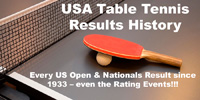Many coaches, including myself for many years, encouraged up-and-coming players to return serves aggressively, even against short serves. So, they learned to flip short serves aggressively, allowing them to control the point. This often worked. But then I noticed that these types of players, in the long run 1) rarely develop good touch with pushing (short or long), and 2) rarely develop a good defense when the other player attacks.
What does this mean? Players who are willing to push long against short serves are developing two things.
First, they develop the backspin ball control that will allow them to push effectively, both long and (later on) short. At higher levels especially, if all you can do is return long (whether pushing or flipping), then opponents just step back slightly and loop everything back at you. That's why top players all need to learn to push short as well - and you can't do that by waiting until you are relatively advanced and then starting from scratch. You are years behind in developing the backspin touch that others learned by pushing serves back, first developing the long push, and then, when you have good backspin control, pushing short as well.
Second, they don't learn how to play effectively when the opponent attacks first. We can all live in a dreamworld where whenever the opponent attacks, we effortlessly counterloop as if we were Ma Long. But realistically, you need to be able to handle many or most of these attacks by blocking, especially on the backhand.
Conclusion? Even if you can flip short serves, if you do it all the time, you are limiting your development. Instead, learn to both flip and push (both long and short), and learn to deal with opponent's attacks. (Learn to push long effectively before learning to push short.) And here's the part that you may most need to hear. If you generally have trouble with the opponent's loop when you push long, then guess what you need to do? Push long in practice games as a regular thing until you both have an effective deep push, and are comfortable with the opponent’s loops. When that happens, you'll be a better player.





